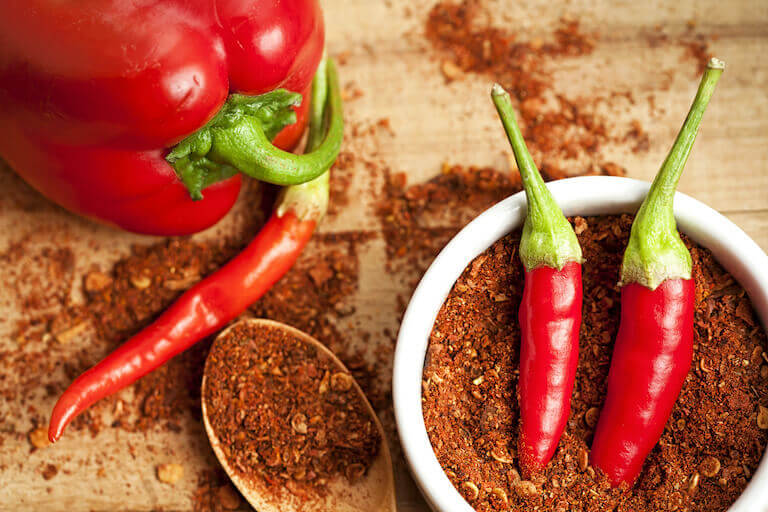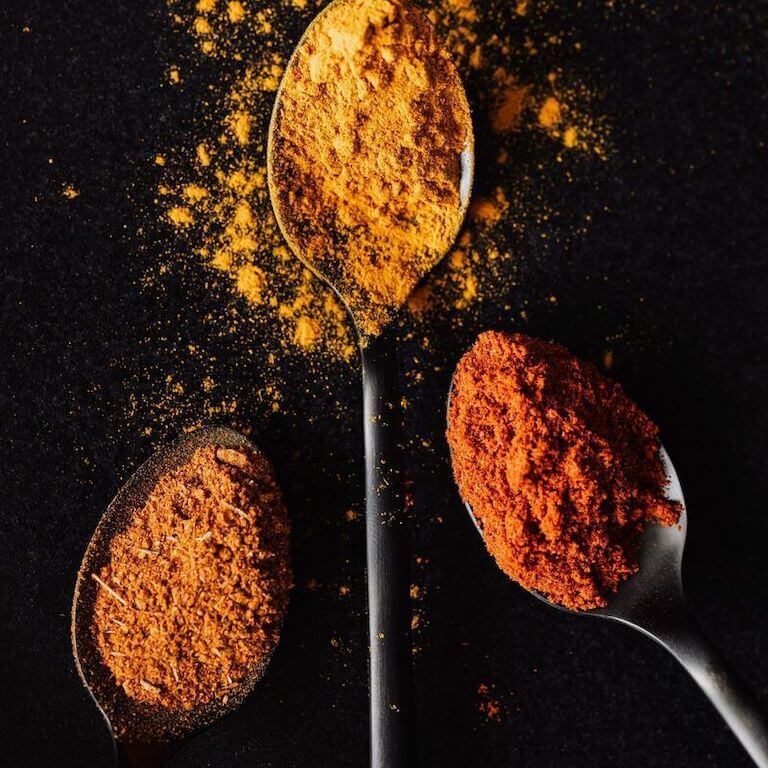Listen to This Article:
Are you tired of relying on salt and pepper alone to spice up your dishes? Paprika, a spice from dried ground peppers, offers a range of heat variations and a punch of crimson color to add some variety to your recipes. So, while you may be familiar with sprinkling a little paprika on your deviled eggs for a touch of color, paprika is a versatile champion in the spice world. Its flavor variations, from sweet and mild to deep and earthy, lend themselves well to many different cuisines and dishes.
This guide will explore the ins and outs of paprika to help you enjoy its delicious benefits at mealtime. When you understand the different kinds of paprika and the results they deliver, you can unlock the potential to elevate your dishes with this simple and powerful spice.
What Is Paprika Made of?
While many people believe the ground spice comes from a paprika pepper, there is no such thing. Instead, paprika derives from the ground fruit of various species of Capsicum annuum plants. These plants produce bell peppers and chili peppers, which allows for a range of flavors and temperatures from mild to hot.

Paprika is made from a variety of dried and ground peppers, such as bell peppers and chili peppers.
Other common spices deriving from the Capsicum annuum plant include cayenne pepper and chili powder. However, the latter often includes additional spices like garlic powder, cumin, and oregano.
The Journey of Paprika Throughout History
It’s believed that the Capsicum annuum plant is native to Central America and South America. However, the spice is now popular in European dishes, such as Chicken Paprikash in Hungary, Paella in Spain, and the vegetable stew known as Gyuvech in Bulgaria.
The story goes that Christopher Columbus brought pepper seeds back to Europe in 1493. The plants became less pungent and sweeter in Europe than in their native state. Eventually, the plant spread across Europe, Africa, and Asia, where different varieties were created.
While it’s not known exactly when people began drying and grinding the plants into paprika, the spice grew in popularity and eventually became the national spice of Hungary. It’s now incorporated into dishes around the world.
What Does Paprika Taste Like?
Have you ever wondered if using paprika instead of smoked paprika really makes a big difference in a recipe? Or maybe you’ve pondered which paprika you should choose from the spice aisle at the store. There are different types of paprika, each with its own unique flavor and hue. Understanding the distinct differences among the types can help you choose the right one for the right dish.
Overall, paprika brings a deep, earthy flavor to food, adding to its complexity. However, depending on the type of paprika used, the flavors can range from mildly sweet and smoky to noticeably hot. For example, what most of us know as regular paprika provides a subtle sweetness, while Hungarian paprika can provide more of a pungent heat.
Let’s dive into the common types of paprika to help you determine what type to use with each recipe.
Choosing the Right Paprika
| Type of Paprika | Description | Hue | Best Uses |
|---|---|---|---|
| Sweet Paprika | Sweet paprika is the most common form of paprika used. It’s made from fully ripened peppers, providing a vibrant color, and processed with little to no seeds to provide a mild, slightly sweet flavor with little to no heat. | Bright Red | Adds color and a touch of sweetness to deviled eggs, potato salad, chicken paprikash, dips, and sauces, and is sprinkled on finished dishes for garnish. |
| Hot Paprika | Hot paprika is made from peppers with a higher capsaicin content, resulting in a spicier heat and kick. The heat level will still vary based on the type of pepper used and how it’s processed. | Orange – Red – Deep Red | Adds heat and depth to stews, chili, stir-fries, marinades, rubs for meats, and spicy dips. |
| Smoked Paprika | Smoked paprika is made from peppers that are dried over smoke before grinding. This adds a smoky depth and complexity to dishes, even if the base paprika is sweet or mild | Deep Red – Brown | Enhances flavor in barbecue rubs, deviled eggs, dips, stews, grilled or roasted vegetables, and adds a smoky touch to finish various dishes. |
| Hungarian Paprika | There are eight classifications of Hungarian Paprika. It’s known for having complex flavor profiles beyond heat. The mildest is a light red with a mild flavor known as különleges. The hottest is a light brown-orange color and is known as erös. | Varies (Bright Red to Deep Reddish-Brown) | Classic ingredient for Hungarian dishes like goulash and chicken paprikash. Use according to the specific classification’s heat level (sweet for general use, hot for a spicy kick). |
| Spanish Paprika | It is particularly renowned in the La Vera region. Spanish Paprika is traditionally smoked using oak fires, producing a more pronounced smoky flavor than other smoked paprika varieties. | Deep Reddish-Brown | Adds a smoky dimension to Spanish dishes like paella and chorizo. Great for deviled eggs with a smoky twist, barbecue rubs, and finishing touches on grilled meats and vegetables. |
Taste Variations in the Types of Paprikas
The variations in the heat and flavor of paprika come from the types of peppers used from the Capsicum annuum plants and how they are processed. Sweet paprika is made from the flesh of the fruit while removing the seeds, which results in a mild flavor and reduced heat. On the other hand, hot paprika tends to be made from cayenne peppers and may even be ground with the stems and ribs to help increase the heat the spice delivers.
It’s important to note that while hot paprika delivers more heat than sweet paprika, it’s still considered mild to moderate heat. The spiciness of peppers is gauged by the Scoville Heat Unit (SHU). Sweet paprika is below 500 SHU, hot paprika ranges from 2,500 to 8,000 SHU, and for comparison sakes, cayenne pepper falls between 30,000 and 50,000 SHU.
So, the type of pepper used and the processing method affect the flavor and level of heat in paprika.
More Than Just Taste: The Color of Paprika
The pepper selection and processing method also impacts the color of the paprika seasoning. Peppers with more beta-carotene produce brighter red hues, while those with more capsanthin, which translates to more heat, tend to be on the orange side or even have a reddish-brown hue. In addition, fully ripe peppers tend to have deeper crimson hues, while unripe peppers are lighter in color.

The hue of the spice depends on the types of peppers used and how they are processed.
You can also alter the color of paprika based on the drying process. Peppers that are peeled prior to drying result in paprika with a less vibrant hue. Allowing the sun to dry the peppers can leave the color slightly faded compared to smoking peppers, creating a deeper shade of red, even a reddish-brown hue.
With this information in mind, you can see that each type of paprika has its own distinct benefits. Looking to add a smoky hint to your dips, stews, grilled vegetables, or barbecue? Smoked paprika it is. Interested in adding just a subtle kick to your potato salad or Chicken Paprikash? Sweet paprika can do the trick.
Is Paprika Good for Your Health?
There are many connections between wellness and holistic nutrition, and it’s believed that incorporating paprika into dishes may have health benefits in addition to its flavorful and visual benefits.
While citrus fruits are known for their high vitamin C content, Nobel Prize-winning Hungarian chemist Albert Szent-György discovered that paprika has more vitamin C pound for pound. There are many other vitamins and nutrients in Paprika, making it a source of:
- Folate
- Potassium
- Calcium
- Phosphorous
- Vitamin A
- Vitamin B-6
- Vitamin E
- Vitamin K
- Choline
- Niacin
The capsaicin in paprika from the peppers may also have antioxidant properties that have been linked to health benefits such as improved immune systems, improved heart health, anti-aging, and reduced cancer risks.
So, if you need one more reason to include more peppers, like paprika, in your diet, your body may thank you.
Cooking with Paprika: Tips and Tricks
Paprika can elevate the flavor and visual appeal of your dish. The following tips and tricks can help you incorporate the spice into your cooking in ways you may not have thought of before.
Knowing How to Use Paprika
From choosing the right paprika to knowing when to add it to your dish, these tips can help you make the most of the spice in your cooking.
- Sweet vs. Hot: Sweet paprika is a safe all-purpose seasoning choice if you want to add beautiful color and a hint of sweetness. But if you want to raise the heat level of your dish, choose hot paprika.
- Start Small: Remember to start with a little and work your way up as you add paprika. You can always add more if the dish needs it, but you can’t take it away if you overdo it from the start.
- Timing is Key: Paprika can be sensitive to heat when cooking. The flavors of sweet paprika can continue to develop as it cooks so you can add it earlier in the cooking process. However, hot paprika and smoked paprika are best added toward the end to protect their flavor compounds.
- Flavor Pairings: There are a variety of other spices that play well with paprika, including rosemary, black pepper, oregano, cumin, and cinnamon.
Going Beyond the Basics
There are numerous ways to use paprika to bring your dishes up a notch, including the following.
- Add Paprika to Your Regular Dishes: For example, try adding a teaspoon of smoked paprika to your tomato soup to take your soup to a whole new level.
- Elevate Side Dishes: Try leveling up your roasted vegetables by tossing them with olive oil, salt, pepper, and paprika.
- Replace Traditional Ingredients: Instead of using breadcrumbs to coat your chicken, combine sweet paprika, onion powder, garlic powder, and a little cayenne pepper. Dredge the chicken pieces in flour, dip them in beaten egg, and coat them with the spice mixture. Pan-fry or bake the chicken for a crispy, flavorful crust.

Try new dishes to experiment with paprika flavors, such as a Hungarian chicken paprikash.
Expand Your Culinary Flavor Knowledge
Paprika is just one of hundreds of spices you can experiment with to level up your dishes. By diving into the world of spices, you can unlock a universe of flavor possibilities. Each ingredient offers unique characteristics—from heat and smokiness to floral notes and citrusy freshness. As you experiment with new spices and flavor combinations, your cooking can transform from basic to bold, bringing your meals to new heights.
If you enjoy experimenting with new worlds of flavor, you may enjoy courses like World Cuisines as part of culinary school at Escoffier. You can pair your passion for flavor and cooking with skills in the culinary arts to discover new and exciting career options. Contact us to start exploring if a culinary program is right for you.
CHECK OUT THESE ARTICLES NEXT!
- A Guide to Sourdough Bread: Recipes, Traditions & Baking Tips
- Fermented Foods Explained: Cooking and the Science Behind Fermentation
- How To Make The Five Mother Sauces
*Information may not reflect every student’s experience. Results and outcomes may be based on several factors, such as geographical region or previous experience.



